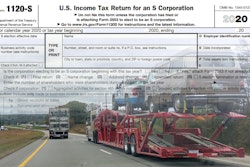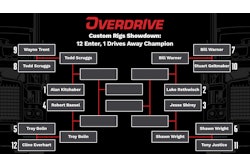If you want to avoid the most common mistakes seen in owner-operator tax returns, you need to get involved in checking the major numbers your tax preparer uses. Doing this can save you thousands of dollars in taxes. Or it could save you thousands of dollars in penalties and interest if your preparer makes a mistake in your favor.
An example: A husband-wife owner-operator team had a feeling something wasn’t right on their return, though it had been prepared by a trucking specialist. The couple had shown a net operating loss on their Schedule C for seven years; an operating loss is often the result of high depreciation. Their most recent tax return, however, showed less than $1,500 in depreciation.
The preparer, following settlement sheets that separated mileage pay from fuel surcharge pay, was including only mileage revenues in the gross numbers. Fuel surcharge payments were listed under “reimbursements,” which is not standard accounting practice. So gross revenue was less than $100,000 each year, even though the per diem showed more than 250 days on the road each year. This is an absolute giveaway that the gross revenue is incorrect.
This mistake resulted in under-reporting income by $20,000 to $40,000 per year for seven years. Tax was underpaid by $3,500 to $7,000 per year. With interest and penalties, the liability could be as high as $75,000.

Here’s what you can do to avoid such situations:
Spot-check your 1099 total. Most leased owner-operators make $1.20 or more per mile with the fuel surcharge included. The number of dollars on your 1099 should be higher than the number of miles you ran during the year. If they’re similar, it’s close to $1 a mile, possibly indicating missing surcharge revenue.
Verify accuracy of the 1099 amount. Having established that the amount is reasonable, go further. A relatively small mistake, like an extra $5,000, wouldn’t jump out, yet you would pay $1,000 in tax you didn’t owe. Verify the amount by adding each settlement to determine your 1099 revenue.
Check at least these three expenses.
- Fuel. You know the rough amount of your weekly fuel spending. Multiply that by 50 (assuming you took off a few weeks) to get a year’s estimated total.
- Maintenance. See how your big expenses add up. If you know you had one $8,000 repair and total maintenance is just over $10,000, there’s probably a mistake.
- Per diem. Look at your Schedule C for meals and entertainment. Take the total number of nights away from home, and multiply it by $80. Then multiply that number by 0.8. That should be your total deductible per diem. In 2021 and 2022, owners could deduct 100% per diem. In 2023, the deduction fell back to 80%, where it remains.
If you find mistakes or red flags for one of these categories, continue checking entries, from largest dollar amount to smallest. If amounts in these are correct, odds are the tax return has been prepared correctly.
How to 'play catchup' on bookkeeping
In the hustle and bustle of many an owner-operator’s day-to-day, too many find themselves staring down the April 15 filing deadline for the prior year’s income taxes and “playing catchup” on months of bookkeeping. For both tax preparation and business engagement, this is a losing strategy.
Yet say it’s January and you’re behind by a full three months in recording revenue and expenses. If you go back and work on October’s numbers first, will that give you any real insight you can use today in terms of decision-making?
A time-honored way to catch up and to truly engage with your business’ performance is to work backward from the most recent period. Take your most recent week and record costs and revenues, then track back another week, then another. If you do it that way, you gain a reward psychologically, because you’re looking at current information: actionable intelligence about your recent business performance.
It’s a way to climb Everest one hill at a time, so to speak, too -- to make a seemingly impossible task achievable.
Always keep in mind that the task of bookkeeping is best done day by day, rather than months in arrears. There’s a self-motivating aspect of engagement with real-time business information, and your performance will be all the better for it.
Read next: Ways to handle per-diem and depreciation deductions and cut against common tax myths












